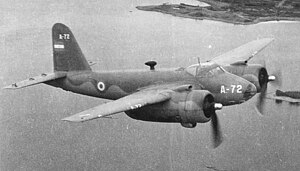I.Ae. 24 Calquin
| I.Ae. 24 Calquin | |
|---|---|
 |
|
| I.Ae.24 Calquin in squadron use, c.1950 | |
| Role | Light Bomber |
| Manufacturer | Fabrica Militar de Aviones (FMA) |
| Designer | Juan San Martin |
| First flight | 4 July 1946 |
| Retired | 1960 |
| Primary user | Fuerza Aérea Argentina |
| Produced | 1947-1950 |
| Number built | 101 |
The I.Ae.24 Calquin (a Mapudungun word which means "Royal Eagle") was a tactical bomber designed and built by the Instituto Aerotécnico (Córdoba) in Argentina in the immediate post-World War II era. Although superficially a "look-alike" for the de Havilland Mosquito, the I.Ae.24 was powered by twin Pratt & Whitney R-1830-G “Twin Wasp” radials giving it a distinct appearance. After an operational career spanning two decades, the Calquin was retired.
Patterned after the successful de Havilland Mosquito, the Calquín had a wooden structure similar to the FMA AeMB.2, and was the first twin-engined aircraft designed and built in Argentina. The I.Ae.24 design was based on a cantilever mid-mounted wooden (indigenous woods were used throughout) wings with fabric-covered flying surfaces. The conventional main twin-oleo undercarriage retracted into the engine nacelles while the tailwheel retracted into the aft fuselage. The two-man crew were seated side-by-side under a large transparency constructed partly of acrylic glass with glass panels. The armament consisted of four 12.7 mm machine guns grouped in the nose. Some examples later had four 20 mm cannons and an internal bombload of 1,764 lb (800 kg) kg along with 12 rockets (75 mm) mounted under the wings.
Originally the I.Ae. 24 was also intended to be equipped with Rolls-Royce Merlins but an adequate supply of the powerplants was not possible, consequently Pratt & Whitney R-1830-G “Twin Wasp” radials of 1,050 hp (782.5 kW) were substituted. Performance estimates of a Merlin-powered variant would have made it comparable to the Mosquito but the R-1830-powered prototype was able to achieve only 273 mph (440 km/h), making the aircraft unstable and prone to stalling. A later prototype, the I.Ae.28 was equipped with Rolls-Royce Merlins but the project was superseded by the more capable I.Ae. 30 "Ñancú".
...
Wikipedia
